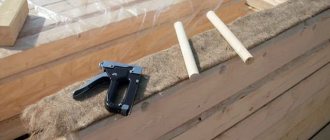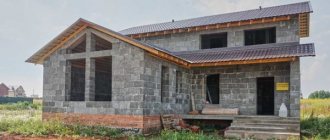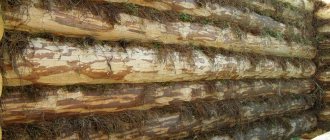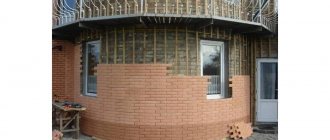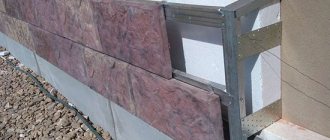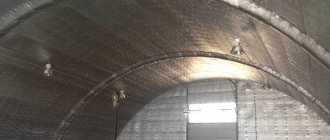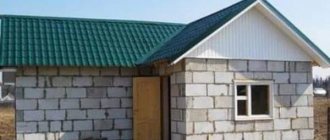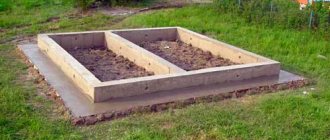We are often asked: what does the price depend on and why are there different prices on different sites for the same rolled jute inter-crown insulation?
We answer:
In the picture below you see jute insulation (jute tape) - 2 rolls. The roll on the left is cheaper, the roll on the right is more expensive.
The roll, in the photo on the left , 20 cm wide and 20 m long, is offered for sale - in all companies. The price of such a roll (left side of the photo) in different retail outlets is from 100 to 160 rubles per roll.
In the photo on the right side there is a roll of inter-crown insulation made of jute, which is offered by our company for 160 rubles (width 20 cm. length 20 meters).
In this clear way, you can understand why some sellers sell their goods cheaper than others.
The answer lies in the quality, density and volume of the product you buy.
You must always understand that a cheap product can end up being much more expensive and worse!
Cheap, in the case of inter-crown insulation made of jute, is not a fact that it is good and profitable!
You can view our prices here...
Graphic dynamics of sales of inter-crown insulation from various materials
This table shows statistics on the use of various types of inter-crown insulation in wooden housing construction (cobblestones and logs).
Row 1 - general statistics on the use of inter-crown insulation from artificial materials such as pp thermo and holofiber - a strong decline in purchases in 2014 - 2015.
Row 2 – general statistics on the use of inter-crown insulation made from thermojute – a noticeable decline.
Row 3 - statistics on the growth in the use of natural materials, such as 100 percent jute inter-crown insulation - tape.
It is clearly seen from this graph that the trend of using artificial (PP-thermo, holofiber) materials and half-artificial materials (such as thermojute) is decreasing annually due to their negative environmental impact on the wood of timber frame structures.
On the contrary, in recent years there has been a noticeable upward trend in purchases of natural insulation materials made from jute – 100 percent.
Expert recommendations
Our recommendation is to carefully choose inter-crown jute insulation when purchasing. It is always worth remembering that the likely reason for the low price of insulation is either an underestimation of the quality of the material or cheap low-quality additives to the thermal insulation material. All this must be understood when you are building a not-so-cheap wooden house from timber or a log bathhouse from rounded or chopped logs.
Photo: this is what a high-quality inter-crown jute insulation should look like, intended for laying in log and timber frames of wooden houses made of wood of natural moisture. It must be clearly understood that for timber and logs with natural moisture, it is best to choose a material of natural origin that is closely related to wood in its parameters. The best and more suitable insulation material is jute fiber. Therefore, the best choice for an inter-crown spacer is a jute tape in a roll, the one in the top photo.
Photo: jute tape for laying under the beam is chosen equal to the width of the beam or 5-10 centimeters larger than the width of the beam in order to ensure that its edges are turned up when laying. This can be seen in the photo posted above.
Photo: jute inter-crown insulation is well suited for laying log wooden structures made of rounded logs. The choice of the width of the tape of this cushioning material depends on the width of the inter-crown groove.
Insulation materials
0 votes
+
Vote for!
—
Vote against!
Wooden houses or log cabins, as a rule, should be built entirely from natural materials. It is usually not customary to cover external walls with anything else, on top of logs. This means that the space between the beams remains open and requires additional materials to seal the cracks. The article will discuss the variety of inter-crown insulation.
- The walls of wooden buildings consist of special structures called “crowns”. That is why the sealant placed between the logs is called inter-crown insulation. This material is intended for thermal insulation of crown grooves and for installation at junctions of window and door structures.
- The wood itself has fairly good thermal insulation characteristics, but if the joints in the walls of the building are not properly sealed, the house will never be warm. That is why, even at the construction planning stage, it is important to think about what material will be used as inter-crown insulation.
- Today, the choice of thermal insulation products is quite large. As a rule, these are all natural, natural products that have a low thermal conductivity coefficient and are similar in properties to wood. In order to make a choice in favor of a specific material, it is necessary to study in more detail the entire offered range and characteristics of products.
Types of interventional insulation
The main characteristic feature of insulation is that it is, first of all, a natural material with low thermal conductivity. Thanks to the special capillary structure, the materials absorb moisture, but dry very quickly. Due to the special properties of the fibers, a comfortable microclimate is always maintained in the house, and natural ventilation is also present, that is, the walls do not stop breathing.
The main classification of insulation materials divides them into two types:
- modern;
- traditional.
Traditional, classic insulation materials include natural materials such as moss, felt, linen or hemp tow. Modern interventional seals are also called tape seals; they are made mainly from jute.
Intercrown insulation moss
- Building moss is a natural material that has good bactericidal characteristics. To insulate wooden houses, varieties such as sphagnum and cuckoo flax are used. You can collect the material yourself, or purchase it ready-made, packed in bags.
- This product is assembled in the forest, in compliance with certain rules. First of all, this concerns the gathering place. The forest should be dry and the area should not be swampy. Coniferous forests where the moss has light moisture are ideal. It is this plant that can be dried to the required condition. Kukushkin flax is somewhat similar in appearance to flax shoots. When harvested, it is red in color, with brown hues. The prepared raw materials do not lose their properties for many decades.
- To preserve all the qualities, you need to take care of this at the procurement stage. Bunches of moss are placed in ribbons and tied to prevent them from falling apart. For tying, it is better to use strong grass; the length of the ribbons is usually 30-45 cm. The prepared material should be dried, but try not to overdry it, otherwise the product will begin to crumble and lose its important qualities. If the moss was collected in dry weather, in non-wetlands, then it can be used immediately for its intended purpose. If the product is collected in rainy, damp weather, then the bunches are hung under a canopy, with access to fresh air and no direct sunlight.
- Insulating a building with such material is not an easy task and requires special skills. Each ribbon should be fluffed a little in your hands, then the strips are laid so that the ends of the bundle hang from the log on both sides (into the house and out). The next tape is laid overlapping the previous one. The layer thickness is approximately 10-15 mm.
- Today, this inter-crown insulation is most often used for bathhouses or small log houses. Especially if the moss grows in nearby forests and it is possible to collect it yourself. The main disadvantages of the products are that over time the material becomes quite brittle, and during the drying process a large percentage of the volume is lost. It is also noted that insects live in moss.
- But thanks to the availability of the material, you can buy this interventional insulation quite cheaply.
Inter-crown insulation tow (hemp or linen)
- Linen inter-crown insulation has been used for several centuries to insulate wooden buildings. In general, in the modern world, tow from flax means any fiber from this plant. However, traditionally such a product was used to refer to waste from the production of linen products that is not suitable for further processing.
- High quality construction tow is flax fiber, marked No. 2 and No. 3. But most often in this industry, material is used that is clogged with foreign impurities by approximately 30% of the total mass. Such fibers are pressed into bales weighing from 10 to 60 kg. Tow is inexpensive and that is why it is still popular. This is an excellent option for inter-crown insulation for timber.
- Hemp tow or hemp is made from hemp. There are two main types of this plant growing in Russia - Central Russian and Southern. Hemp is an annual representative of the flora; its stem reaches a height of 3 m, and sometimes more. It is the fibers in the bast layer that are called hemp fiber or simply hemp. Southern hemp, despite its high yield, is distinguished by coarser fibers, since they have a higher lignin content.
- Hemp tow is very similar to flax, but due to the fact that the yield of hemp is higher than flax, the cost of this product is lower. But it is worth noting that now there is a tendency to reduce the production of materials from hemp fibers.
- Tow (flax or hemp) is very difficult to distribute evenly over the logs. That is why, after the log house is assembled, it is necessary to re-caulk it. It is important to take into account that flax gets wet easily and does not dry well, which is why it is susceptible to rotting or being damaged by fungal and mold formations. Also, this material is most susceptible to ignition, which is considered unacceptable in wooden houses.
- Hemp has been used for caulking for quite a long time; it is coarser than flax tow, but at the same time, it is less susceptible to rotting due to the increased content of lignin (natural resin). But still, this product does not show high quality indicators; it is often stolen by birds.
Modern materials used for insulating wooden buildings are made from natural ingredients - plant fibers (jute or flax) or from sheep wool. The main difference from the classic options is that these products undergo certain factory processing.
Tape inter-crown insulation for log house
The insulation does not require any preparation from the consumer; immediately after purchase it is ready for use. The material is produced in the form of a tape of various widths, which is why this product is called tape insulation. The most common thermal insulation material of this type is tape tow , made from flax or jute.
- Jute today is the leading raw material for the manufacture of inter-crown insulation. This is due to the fact that the lignin content in it is much higher than that of other similar plants and is almost equal to the level of wood. In addition, jute fibers contain minimal brome content (woody parts of stems that clog finished products). Also, the beautiful golden color of the jute tape gives the log house a pleasant appearance, which is important for many homeowners.
- Jute felt is sold in the form of a strip, the width of which (as well as the thickness) can be adjusted to suit the specific parameters of the seams. Initially, the roll has a width of 15 cm, a thickness of 10 mm, and a length of 40 or 50 m. These materials are ideal for buildings made of hand-cut wood, where the crown grooves have an uneven seam thickness. To produce jute sliver, the jute fiber must be combed using a special technique called a carding machine. All fibers have the same direction (longitudinal). This process also allows the fiber to be cleaned of contaminants, primarily from fires.
Modern interventional insulation systems are superior to traditional ones in many respects, featuring many advantages :
- speed up the procedure for assembling a wooden frame, since they do not require any preliminary preparation, the purchased product can be laid immediately;
- a natural product with a high level of environmental friendliness and safety, thanks to a special production technology, almost completely preserving the fibers in their original form;
- due to their special appearance and special properties, they allow you to achieve uniform insulation along the entire seam, even if there are unevenness at the joint itself;
- do not accumulate moisture;
- do not weather in strong winds;
- is an excellent soundproofing and noise-absorbing product;
- after installation, the jute is compacted, turning into a solid mass that is not afraid of external factors;
- insects do not grow in the material, and birds do not take it away;
- ease of installation, due to the fact that the product is supplied in rolls of various widths, you just need to select the required parameters, roll the tape over the laid log, secure it with a construction stapler, and you can proceed to laying the next building element;
- due to the loose structure of the tape material, you can independently vary the width and thickness of the insulating layer;
- there is no need to re-caulk the walls of a wooden house, since jute tapes have a high and uniform density and excellent thermal insulation properties;
- jute tapes can be used for both primary caulking and secondary caulking, in combination with other materials, they perfectly complement any insulation, increasing its initial performance;
- the resulting seam has high aesthetic values, both outside and inside the building, which means that cladding the house from the inside (for example, with clapboard) is no longer required;
- insulation is able to provide a healthy atmosphere inside the house, due to the fact that there are no impurities in the structure of the material, including fire;
- jute tapes can breathe with the house, they absorb moisture and release it as needed, adjusting to the existing humidity level;
- The operating time of jute is very long, only the guaranteed service life is stated at 75 years;
- has high quality and low cost.
Needle-punched insulation
This type of heat-insulating materials includes products made by compacting canvas using special needle-punching or knitting-stitching equipment. These products include flax batting and flax-jute felt. It should be noted that the difference between these products and jute tapes is that with a large percentage of flax added to the composition, they are more susceptible to getting wet, attacked by insects and reducing their thermal insulation qualities.
- Linen or felt is a non-woven material that is produced mechanically. That is, the flax fiber is combed using special machines, laid out in several layers and compacted using needle-punching technology. Special serrated needles, passing through the product, entangle the fibers with each other. There is also a quilted version of this product. In this case, the prepared canvas is stitched with polyester or cotton threads in zigzag stitches.
- Of course, such inter-crown insulation has a lower density compared to jute tapes, and, therefore, has a lower thermal insulation value. It is also worth noting that the option of stitching the fabric with cotton threads is subject to a rapid process of destruction under the influence of moisture. This is due to the fact that cotton is an easy-to-rot material. If the choice was made specifically in favor of flax wool, then you should select a product with a density of at least 500 g/m2.
- Interventional felt made from a mixture of flax and jute is a more reliable insulation material, which, due to the addition of jute to the composition, as well as greater density, acquires excellent resistance to external factors. There are three main types of jute inter-crown insulation: flax fiber, that is, 100% made of flax;
- flax-jute felt, where the composition contains an equal amount of flax and jute (50%/50%);
- jute felt, the structure is dominated by jute, here it is 90%, there are materials with 100% jute fibers, but they are stiffer and crumbly, a small percentage of flax allows you to reliably bind the material fibers together.
Externally, such a product should have high density and uniformity; the material should be carefully inspected for the presence of foreign impurities; only the absence of threads and fires makes the product truly high-quality.
Sheep's wool
- The sealant made from animal hair is excellent at regulating humidity and insulating buildings. The main advantage of this material is that over time it does not cake and does not lose its qualities. The product has a springy structure and can be compressed and unclenched. This, in turn, ensures reliable closure of the seams even after many years, when the logs dry out slightly and the seams are slightly thicker than in the first years.
- The product does not rot and is not affected by fungal growths. In addition, it is an excellent sound insulator. But the price of this interventional insulation is slightly higher than that of its analogues.
A modern interventional insulation polytherm . It is produced without the use of glue and is an environmentally friendly material. It has the longest service life among all known insulation materials for log and log houses.
It is important to remember that materials such as mineral wool, foam rubber, polyurethane or basalt wool (that is, those products that are used for thermal insulation of walls and other elements in the house) cannot be used to insulate crown joints. This is due to the fact that under the weight of a wooden structure they lose their main characteristics, becoming vapor permeable, and therefore the thermal insulation effect is not obtained, and moisture accumulation between the crowns is also possible. Of course, if the house is used for a long time in such conditions, the process of rotting of the logs will inevitably begin.
You shouldn’t come up with something new in the hope of doing better; the best option would be to use exactly the means that have been proven over more than a decade. And which of the described inter-crown seals to choose for a particular case can be decided independently, relying on the knowledge gained.
Where is the best place to buy jute interventional spacers?
For 10 years, we have been specializing in the sale of natural inter-crown seals (insulations) intended for the construction of high-quality, heat-efficient log and beam wooden houses and log bathhouses made of timber and logs. But the sale of thermal insulation materials for log houses is not a complete list of products from our Winter House Group of Companies.
Our list of building materials includes a wide range of components for wooden house construction. From us you can buy numerous fasteners for assembling wooden houses - dowels, dowels, spring units “Strength”, galvanized corners and supports, screw jacks “Shrinkage Compensators”.
We are direct dealers of wood protection products of the Neomid and Prosept brands. We can offer good wholesale prices for decorative jute ropes and cords, acrylic sealants for log houses, Vilaterm and Izokom cords.
Technology of thermal insulation of walls with inter-crown insulation
Choosing a method of insulation
- Laying the tape without bends
. The method is used in the construction of houses from laminated veneer lumber, which is distinguished by high quality workmanship. The material is placed on the surface of the top row in one layer and secured with a construction stapler. - Laying inter-crown insulation with a one-sided bend
. This method is used in houses made of profiled timber. During installation, the material is folded in half, folded inward, with a distance of 5 mm from the edges, and secured with a stapler. This option is used when installing a house or bathhouse made of profiled timber with natural humidity. After the lumber dries, cracks may appear on one side of the wall, so the sealant is bent. When determining the amount of insulator, keep in mind that you will need twice as much. - Laying with double-sided bend
. It is used in houses made of chopped or rounded logs, in which the width of the groove for the insulation varies along the entire length of the wall. To be able to adjust the width of the strip, it is folded on both sides. The thickness of the inter-crown insulation for a log house can be increased by placing tow inside. If after the start of operation of the house there is a need for additional insulation, finish caulking of the cracks is carried out using tape material or tow.
Recommendations for material selection
The choice is also influenced by the density and thickness of the insulation:
- A seal with a thickness of 3-4 mm and a density of 300-400 g/cm2 is used in massive rooms, for example, in baths.
- Tapes with a thickness of 4-5 cm and a density of 500-600 g/cm2 are used with heavy rounded logs.
- Strips 8-10 mm thick and with a density of 700-800 g/cm2 are used to insulate two-story buildings.
- Trouble may arise if the thickness of the inter-crown insulation is 6-7 mm and the density is 300-400 g/cm2; bald spots will soon appear between the logs. Similar problems will also arise if the tapes are 5-6 mm thick and have a density of 700-800 g/cm2. Rigid products will not be able to fill all the voids.
Making a groove in a log
The dimensions of the groove depend on the minimum winter temperature of the area where construction is taking place:
- Minus 20 degrees - sample width is at least 10 cm;
- Minus 30 degrees - at least 12 cm;
- Minus 40 degrees - at least 14 cm;
- General recommendations - the width of the longitudinal groove should be at least half the diameter of the log.
Laying inter-crown insulation
- Inspect the grooves on the beams into which the insulator will be laid. As a rule, they are done by hand and of average quality, so you need to stock up not only with strips of insulation, but also with tow, which will help fill the remaining gaps.
- Drill a hole in the timber for the dowel.
- Clean the profile from splinters. You can saturate the groove with insecticide and rot-proofing agent.
- Place a roll of material on the log and roll it out to its full length along the wall according to the chosen installation method. The inter-crown insulation for the timber should not reach its edge by 5 mm.
- If the lumber is roughly processed, choose wide strips so that they hang 5 cm on each side. The extra parts will be needed to caulk the wall. The thickness of inter-crown insulation for logs or roughly processed beams can reach 15 mm. If necessary, the strips can be laid in two layers.
- Secure the tape with a staple gun, driving the staples in a checkerboard pattern.
- Make a hole in it for the dowel.
- Place a log on top, which should securely clamp the product. Make sure there are no gaps between the decks, especially if they are uneven or roughly processed. Install dowels into the holes and connect the beams.
- If there are strips hanging from the logs, perform initial caulking. To do this, use a chisel to push the tape 0.5-1 mm deep into the crack. You can lightly tap the chisel with a mallet.
- If you feel that the insulation has stopped falling, stop the process and carefully cut off the excess parts.
- Continue working on the next section in a circle.
- After sealing the gaps at one level, it is necessary to caulk the same level from the inside so as not to warp the frame.
- Repeat the operation at the next joint. The work is not difficult, but long. It may take several days to repair the cracks.
Many synthetic sealants, such as Polytherms, are sold with an adhesive backing. Before laying inter-crown insulation from the surface, remove the protective tape and glue the product to the wood.

